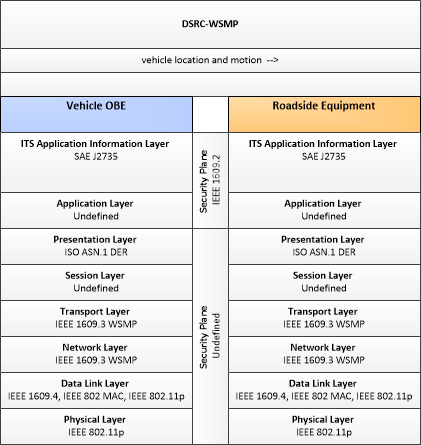Link Type: Short Range Wireless
Vehicle OBE --> Roadside Equipment:
vehicle location and motion
Definitions
vehicle location and motion (Information Flow): Data describing the vehicle's location in three dimensions, heading, speed, acceleration, braking status, and size.
Vehicle OBE (Source Physical Object): The Vehicle On-Board Equipment (OBE) provides the vehicle-based processing, storage, and communications functions necessary to support connected vehicle operations. The radio(s) supporting V2V and V2I communications are a key component of the Vehicle OBE. This communication platform is augmented with processing and data storage capability that supports the connected vehicle applications.
In CVRIA, the Vehicle OBE includes the functions and interfaces that support connected vehicle applications for passenger cars, trucks, and motorcycles. Many of these applications (e.g., V2V Safety applications) apply to all vehicle types including personal vehicles, commercial vehicles, emergency vehicles, transit vehicles, and maintenance vehicles. From this perspective, the Vehicle OBE includes the common interfaces and functions that apply to all motorized vehicles.
Roadside Equipment (Destination Physical Object): 'Roadside Equipment' (RSE) represents the Connected Vehicle roadside devices that are used to send messages to, and receive messages from, nearby vehicles using Dedicated Short Range Communications (DSRC) or other alternative wireless communications technologies. Communications with adjacent field equipment and back office centers that monitor and control the RSE are also supported. This device operates from a fixed position and may be permanently deployed or a portable device that is located temporarily in the vicinity of a traffic incident, road construction, or a special event. It includes a processor, data storage, and communications capabilities that support secure communications with passing vehicles, other field equipment, and centers.
Included In
This Information Flow is in the following Applications:
- Cooperative Adaptive Cruise Control
- Curve Speed Warning
- Incident Scene Work Zone Alerts for Drivers and Workers
- Intermittent Bus Lanes
- Pedestrian in Signalized Crosswalk Warning
- Pedestrian Mobility
- Railroad Crossing Violation Warning
- Red Light Violation Warning
- Reduced Speed Zone Warning / Lane Closure
- Restricted Lane Warnings
- Stop Sign Gap Assist
- Stop Sign Violation Warning
- Warnings about Hazards in a Work Zone
This Information Flow is in the following Application Objects:
- RSE Environmental Monitoring
- RSE Intersection Management
- RSE Intersection Safety
- RSE Rail Crossing Warning
- RSE Restricted Lanes Application
- RSE Speed Warning
- RSE Traffic Gap Assist
- RSE Traffic Monitoring
- RSE Traveler Information Communications
- RSE Work Zone Safety
- Vehicle Basic Safety
- Vehicle Gap Assist
- Vehicle Intersection Warning
- Vehicle Rail Crossing Warning
- Vehicle Restricted Lanes Application
- Vehicle Roadside Information Reception
- Vehicle Speed Management Assist
Communication Diagrams
The communication diagram(s) can be viewed in SVG or PNG format and the current format is SVG. Switch to PNG format.
Characteristics
Architectural:
| Characteristic | Value |
|---|---|
| Time Context | Now |
| Spatial Context | Adjacent |
| Acknowledgement | False |
| Cardinality | Broadcast |
| Initiator | Source |
Security
This information flow triple is in the following applications with the following security levels.
| Information Flow Security | |||||
|---|---|---|---|---|---|
| Application | Confidentiality | Integrity | Availability | ||
| Basis | Basis | Basis | |||
| Incident Scene Work Zone Alerts for Drivers and Workers | Not Applicable | Moderate | Low | ||
| This data is intentionally transmitted to everyone via a broadcast. It can also be determined via other visual indicators. | False information here could lead to a false warning, or not receiving a warning when an infraction is about to occur. A few false warnings should not have a bad consequence. When an emergency personnel receives a warning they can look around and verify whether or not a vehicle is actually headed towards them. If a warning is not sent due to incorrect data, there are also many other visual indictors that should stop a driver from causing an infraction. | It would be better to receive any messages than to not have this application available due to availability requirements. However, the higher the availability here, the more useful the application will be and the more emergency personnel can rely on it. | |||
| Pedestrian in Signalized Crosswalk Warning | Not Applicable | High | Moderate | ||
| This data is intentionally transmitted to everyone via a broadcast. It can also be determined via other visual indicators | Incorrect information could lead to the system not operating properly. If the system does not properly know where the vehicle is, it cannot make an accurate decision about whether there is going to be a pedestrian in the crosswalk that the vehicle is approaching. This can have a safety impact. | This data is required for the system to operate properly. If this data is not available, the system cannot give accurate warning information. | |||
